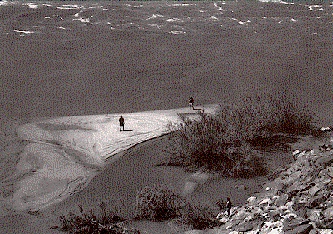

|
|---|
 Summer 1996 |
The following article is an excerpt taken from the Summer 1996 issue of the Colorado Plateau Advocate,
a publication of the GRAND CANYON TRUST.
by Tom Moody, Conservation Consultant for the Grand Canyon Trust
| On March 26, 1996, after years of encouragement by the Grand Canyon Trust and others, the Bureau of Reclamation conducted a historic experiment at Glen Canyon Dam. The Habitat/Beach Building Test Flow, designed as part of the Glen Canyon Dam Environmental Impact Statement under the Grand Canyon Protection Act, tested the effectiveness of using the dam to directly benefit the downstream ecosystem of the Colorado River in the Grand Canyon. Tom Moody, the Trust's Colorado projects manager was there to see it - and, in fact, was given the honor of opening the third jet tube in recognition of the Trust's efforts. He recorded these thoughts on his experience. |

| |
| Birth of a sandbar | Tom Moody |
March 26 - 5:30 A.M., base of Glen Canyon Dam. Stars shine overhead, the black sky slowly giving way to the encroaching daybreak. Everyone here wears green hard hats, and you can feel the deep hum of the dam in your bones. The small parking area is packed with media trucks, satellite dishes, and enough cable to wire a small city. Since midnight the river flow has risen from 8,000 cubic feet per second (cfs) to 30,000, full power-plant capacity. In a few minutes the jet tubes will be opened, raising the flow to 45,000 cfs. The tubes protrude over the river directly under our feet, four of them, each eight feet in diameter and capable of shooting water two hundred feet over the river. The spectacle will begin shortly.
In a short speech, Secretary of the Interior Bruce Babbitt underscores the significance of managing the dam for the entire river ecosystem, and the importance of this occasion, equating it to the dedication of the dam itself almost thirty-five years ago. Then he unleashes a roaring jet of water. This historic event would not be taking place without the hard work of Grand Canyon Trust, the Grand Canyon river guides, and other conservation groups who helped to lobby the Grand Canyon Protection Act through Congress in 1992. Fittingly, some of us who have labored for this moment over the years will open one of the jet tubes. With Dick White, who operates the dam for Reclamation, we complete the sequence of valves and levers; the concrete vibrates beneath our feet, and tube number three explodes below us. Above the roar of the water. Standing arm in arm with those who operate the dam, I think of the distance we have come, the great strides that have been made by the thousands of people who believed that the Grand Canyon deserved better. Let the river roll!

|
|
Secretary of the Interior Bruce Babbitt (center) and Trust president Geoff Barnard (left) at Lees Ferry for the flood, March 1996. Photo by Eric Howard |
March 28 - Lees Ferry. At 45,000 cfs the river really moves along. Even in upper Marble Canyon, where sediment storage is scarcest, sand boils to the surface. The beaches are underwater; here's hoping sand is accumulating. We launch our boats.
March 31 - Phantom Ranch. The Little Colorado River, when we passed it, was a huge blue lagoon stretching up out of sight around the corner. Hance Rapid was big but roomy, the inner gorge a seething mass of swirling waters. Sedimentologists are busy at Eminence Break and Carbon Canyon, repeatedly surveying the river bottom to document gain or loss in sand. Fisheries scientists track the movements of the endangered humpback chub. Although most beaches are still underwater, to see the Colorado muddy is enough to make your heart swell.
April 3 - 122 Mile Canyon. It's an exciting moment as the river begins to drop. The scientists know deposition here was greater than predicted; several pieces of equipment were unexpectedly buried under as much as ten feet of sand. Fascinated, we watch new bars being born, stand on their fresh surfaces, make first tracks along their smooth faces.
April 6 - Diamond Creek takeout. The river is now down to a steady 8,000 cfs. For the past hundred miles we have seen much new sand along the river. At some places, bars are calving in sharp cutfaces, adjusting to the lower flows, but many seem pretty stable. Only time will tell.
We can't help but wonder how Glen and Marble Canyons fared With the smallest amount of sediment available, their beaches are the most critical. How did the endangered native fish fare - were fresh backwater s formed and will they take advantage of them? Will the trout and their food supply rebound at Lees Ferry? How long will new beaches last? How will the system as a whole be affected by the subtle, longterm impacts of this disturbance? In time, we'll know these answers and more. To me, even at this point, the flood was a success. The river was able to redistribute sediment and we had the opportunity to learn from the experience. More floods like this should follow in coming years, and the knowledge gained in the past week will make them even more effective, balancing the benefits to downstream resources with impacts to power and other resources.
We have been part of a significant point in conservation history As Secretary Babbitt said, "This test is an appropriate symbol of a new way to manage our rivers." Grand Canyon National Park Superintendent Rob Arnberger put it well when he characterized this as a payoff to the American people for passage of the Grand Canyon Protection Act. We as a society have chosen to use our technology and knowledge to restore a national treasure, the ecosystem of the Colorado River through Grand Canyon. We can all take a bow.
![]()
| -- Tom Moody |
|
|
|---|
|
|---|